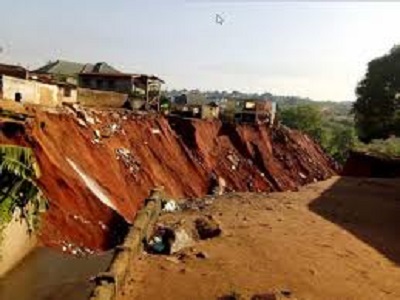CAMIC urges govt to tackle gully erosion in Nigeria

By Obiabin Onukwugha
The Climate Africa Media Initiative Centre (CAMIC) has called for collaborative efforts from government and relevant stakeholders to combat rain-induced soil erosion in Nigeria.
This comes as the body provided a set of strategies aimed at mitigating erosion in communities.
These strategies, according to the body is critical in responding to the increasing challenges posed by climate change, which exacerbates soil erosion and negatively impacts agriculture, infrastructure, and ecosystems across the African continent.
According to CAMIC, as the rainfall patterns become more erratic and intense, the threat of soil erosion looms larger, leading to loss of fertile land, sedimentation in water bodies, and destruction of property.
CAMIC, in a statement released in Abuja on Tuesday, said it will conduct workshops and training sessions to educate local communities about the causes and consequences of soil erosion and the best practices to combat it.
“Empowering communities with knowledge is crucial for the successful implementation of erosion control measures. CAMIC is committed to addressing these issues through sustainable and community-focused solutions,” the statement read in part.
The body, which is a non-governmental organization dedicated to advancing environmental sustainability and combating climate change emphasized the importance of planting trees in erosion-prone areas.
It said: “Trees act as natural barriers, reducing the velocity of rainwater runoff, and their roots help to stabilize the soil. Community-based tree planting programs will be initiated to restore degraded lands.
“Introducing terracing and contour plowing in hilly and sloped agricultural areas can significantly reduce soil erosion. These practices slow down water runoff and promote water infiltration, which helps maintain soil integrity.
“Building check dams and retention basins in strategic locations can capture and store runoff water, reducing the speed and volume of water flow that causes erosion. These structures will also provide additional water resources during dry periods.”
It continued: “Promoting the use of vegetative cover crops and mulching techniques can protect the soil surface from direct impact of raindrops. This practice helps to maintain soil moisture, reduce runoff, and improve soil health.
On Community Education and Engagement: “Encouraging sustainable farming methods, such as agroforestry, crop rotation, and conservation tillage, can improve soil structure and reduce erosion. These practices also enhance soil fertility and resilience to climatic changes.”
CAMIC, therefore pledged it’s readiness to collaborate with government bodies to advocate for policies that promote soil conservation and sustainable land management.
“Supportive policies and funding are essential to scale up erosion control efforts,” the statement added.
